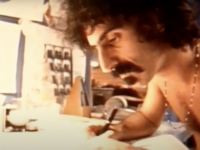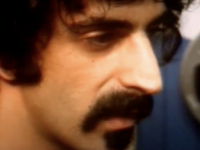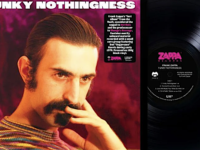This is the second in a three-part series from Mick Raubenheimer examining Frank Zappa’s ‘Joe Garage,’ itself a three-part rock opera which arrived in September and November 1979:
Chapter three: Philosophical signature.
or: Assaults on linearity.
One of Frank Zappa’s key artistic characteristics is his unconventional use of rhythm – Neptunian, as virtuoso guitarist Steve Vai coined it. In fact, it can be reasonably argued that a fascination with time (as the experiential medium of human experience and perception) underscores and motivates all of Zappa’s compositional output, and that his musical legacy would be the sheer inventiveness of his use of rhythm, “time,” in composing.
The crude and vulgar lyrical structures in Joe’s Garage are always complemented or interrupted by musical beauty, be it the beauty of intricate, advanced musicianship or the more conventional beauty of melodic and rhythmic structures themselves. Note here Zappa’s self-revelatory claim that “lyrics exist for those who need them.” This chapter will attempt to show that in Joe’s Garage, as in all his work, Zappa’s most incisive and dramatic intellectual statements and gestures are mediated through the music – that is, the instrumental structures and their design, rather than the “songs.”
As a composer, Zappa has striven to create a musical signature, a music which derives from and communicates his personal aesthetic philosophy. To achieve this, he has systematically broken down and refracted the stylistic influences from which his music was borne, arriving at a style so multifariously inflected by existing musical genres as to be foreign to all of them, and eventually concocting out of this complex beast a musical aesthetic suggestive only of itself.
This process in itself demands a book-length essay for proper investigation, as such will only be touched on here. The name Frank Zappa has assigned to the contours of this process, and the eventual design of its realization (for the former is subsumed in the latter) is Conceptual Continuity, a notion which informs and defines every aspect, every moment, of Zappa’s art.
Expressed as a formula, Conceptual Continuity is “the when determining the what,” which is pretty vague but a helpful clue nonetheless:
By reducing music to its foundations – that is, a function of audio harmony, tension and opposition – stylistic elements become purely aesthetic manipulations, i.e. are stripped of prescriptive force. Any form of sound or sound pattern can now be introduced into the linear structure without disrupting it, given that its presence is accounted for compositionally, i.e. follows the piece’s internal logic. Zappa’s challenge here has been the realization of a compositional context which can cope with and absorb any conceivable sound event into itself.
Sub-theme stirring: a musical equivalent to noise.
A not-too-incongruent model for Zappa’s realized compositional context/frame is noise: Noise taken as a linear aural event cannot be disrupted by any additional sound events. Within the linear parameters (e.g. two minutes of noise), it translates any sound into itself – noise as self-improvisational. The reason for noise’s compositional supremacy is the modest fact that it defines itself as it unfolds – no aural event or relation challenges its structure. Even the absence of sound becomes merely a sly note tucked into its fretboard, its grammar. Noise has no stylistic politics.
As a musical analogy, noise is nothing other than the audio traces of time doing its thing. And “composing,” Frank Zappa says, “is the act of decorating time” – nothing more or less than pinning intriguing or entertaining sounds to various points in time, with music being merely the interrelations between these aural moments.
In Joe’s Garage, Conceptual Continuity rears its beautiful head in the instrumental and improvised sections, with the guitar seemingly digesting on and reacting to the various insane and tight melodic and rhythmic cluster-runs. With the album, Zappa employs into his sly compositional repertoire a fitting Conceptual Continuity technique which he coins “xenochrony.” A compound of the Greek roots “Xeno” (foreign or alien) and “Chronos” (time), Xenochrony is that smugly and snugly pseudo-improvisational event where for example a lead solo from a past compositional context is spliced into an entirely unrelated rhythm setting.
As the man explains: “A classic Xenochrony piece would be ‘Rubber Shirt,’ which is a song on the Sheik Yerbouti album. It takes a drum set part that was added to a song at one tempo. The drummer was instructed to play along with this one particular thing in a certain time signature, 11/4, and that drum-set part was extracted like a little piece of DNA from that master tape and put over here into this little cubicle.
“And then the bass part, which was designed to play along with another song at another speed, another rate in another time signature, 4/4, that was removed from that master tape and put over here,” Zappa adds, “and then the two were sandwiched together. And so the musical result is the result of two musicians, who were never in the same room at the same time, playing at two different rates in two different moods for two different purposes, when blended together, yielding a third result which is musical and synchronizes in a strange way.
“That’s Xenochrony,” he concludes, “and I’ve done that on a number of tracks.”
- How the Pixies Changed Everything With ‘Surfer Rosa’ - July 12, 2023
- Frank Zappa – ‘Funky Nothingness’ (2023) - June 30, 2023
- How Jim White’s ‘Wrong-Eyed Jesus!’ Changed My Mind About Country Music - June 14, 2023




